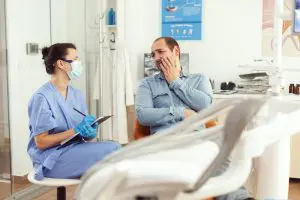Dental emergencies are never ideal, but unfortunately, they happen anyway. Prevention with excellent dental hygiene is the best way to avoid dental emergencies. Still, sometimes, even the most dental hygiene-obsessed person faces a dental crisis, and knowing how to react can help prevent long-term damage.
Here are seven of the most common dental emergencies:

(DCStudio/Freepik)
1. A Toothache
A painful tooth is not a happy and healthy tooth. An aching tooth can indicate several conditions, such as tooth decay. Some toothaches might be manageable without urgent attention, but if you have specific symptoms such as swelling, you won’t want to wait for care.
If you are experiencing a toothache with swelling, try to avoid taking common painkillers such as aspirin because contact with your infected gums will potentially burn the tissue. Yikes, right? Even though it’s very tempting to pop a painkiller when you’re in obvious pain, instead try applying cold compresses to the outside of your cheek and call your Davis County dentist for emergency attention. Once your treatment is over, listen to the advice of your dentist on the best dental hygiene practices to prevent another toothache.
2. A Chipped or Broken Tooth
Even the most diligent brusher and flosser might bite down on something too hard or trip and bang their tooth on a hard surface. What a nightmare. A chipped tooth can be humiliating, and on top of that, it can hurt. If you find yourself in this horrible situation, try rinsing your mouth with warm water and then apply some gauze if you have bleeding. Next, apply cold compresses to the part of your face nearest to the chipped or broken tooth to reduce swelling and relieve the pain. Then, give your Utah dentist a call for emergency care.
3. A Knocked Out Tooth
If you think a chipped tooth is awful, imagine your whole tooth getting knocked out. This dental emergency is most common in the sports world. Things happen. If you find yourself in this nerve-wracking situation, pick the tooth up by the crown (the part exposed in the mouth) and rinse off the root if it is dirty. If it is not dirty, avoid any scrubbing to avoid removing attached tissue fragments. Sometimes, you can put the tooth back in place, but be careful not to push it into the socket. The sooner you put the tooth back in, the better your chances are of saving it and restoring it to normal.
If you can’t reinsert your tooth, place it in a small cup with milk or water with a pinch of salt to help preserve the tooth on the way to the dentist for emergency restoration.
4. Lost Crown or Filling
We use fillings and crowns to restore previously damaged teeth. Fillings and crowns can give your tooth its appearance and function back. So, a broken filling or crown is an emergency and needs urgent attention to prevent reinfection or further damage.
In the meantime, try sticking a piece of sugarless gum into the cavity. Get to your dentist as soon as you can. Place the filling or crown into a plastic baggy to see if they can reapply it. If not, they’ll fit you for a new one.
5. Broken Braces
Your braces will rarely break. Those metal wires and brackets can usually withstand the natural wear and tear of eating. However, sometimes they do break and possibly stick out, poking your gums and cheeks. It’s more of an uncomfortable nuisance than anything. But, if your braces are damaged, they’re also not working correctly to straighten your teeth.
If you or your child’s braces break, you can push the broken wire into a more comfortable position. If that doesn’t work, you can apply wax, a cotton ball, or some gauze to the exposed end to prevent the wire from poking you and causing pain. Do not, under any circumstances, cut the wire.
6. Reaction After a Tooth Extraction
Some degree of bleeding and pain is standard after a tooth extraction, but if it persists even an hour later, call your dentist. While waiting, place gauze over the extraction site and bite down on the gauze to apply pressure. In the meantime, avoid eating, drinking, rinsing, sucking, spitting or smoking.
7. Abscess
A dental abscess is a collection of pus that forms inside the teeth, gums, or bone. Abscesses are serious and won’t go away without treatment. When left untreated, they can spread to surrounding teeth and gums, and in severe cases, they can spread to other parts of your body. If you think you may have an abscess, check your gums for any painful bumps that resemble a pimple. If you believe you have an abscess, call your dentist right away.
Dental emergencies are not fun, but they do happen. Now you know what to do if you experience any of the above. It’s important to stay calm in an emergency. Take any action that might help in the moment and call your Utah Family Dentist as soon as possible.
